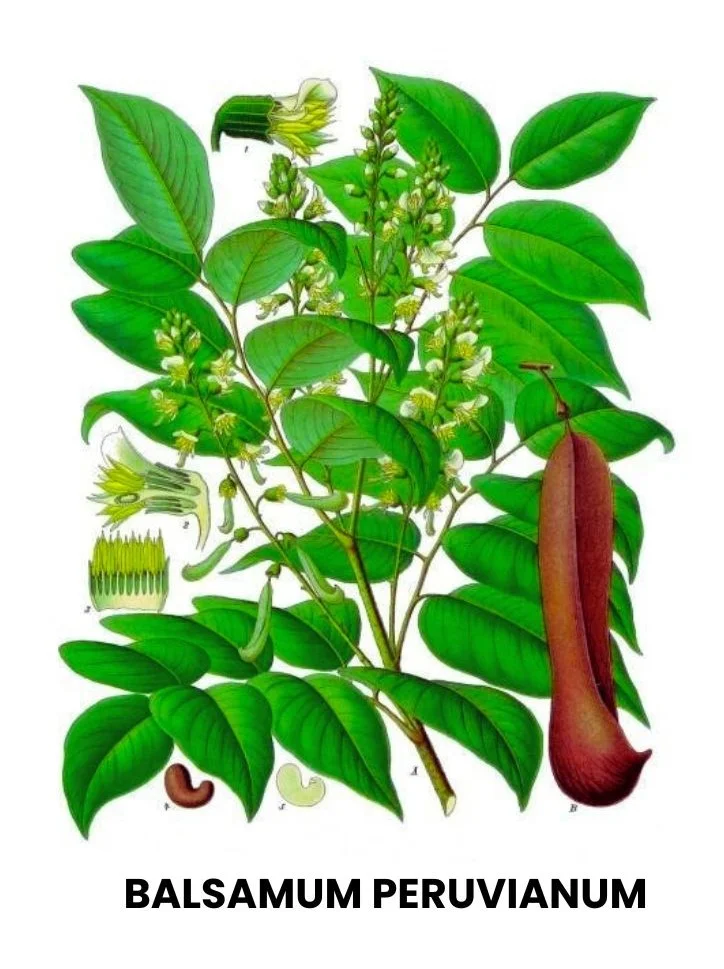Balsamum peruvianum, or Peruvian Balsam, is a homoeopathic remedy derived from the resin of the Myroxylon pereirae tree.
It is known for its efficacy in bronchial catarrh, chronic bronchitis, and other respiratory conditions with copious, purulent expectoration.

Table of Contents
ToggleSOURCE INFORMATION
Scientific Classification
- Kingdom: Plantae
- Order: Fabales
- Family: Fabaceae
- Genus: Myroxylon
- Species: Myroxylon pereirae
Origin
- Balsamum peruvianum, commonly known as Peruvian Balsam, is derived from the resin of the Myroxylon pereirae tree.
- The tree is native to Central America and South America, particularly Peru and El Salvador, where it has been traditionally used for its medicinal properties.
Historical Facts
- Peruvian Balsam has a long history of use by indigenous peoples in Central and South America for various medicinal purposes, including wound healing, respiratory ailments, and skin conditions.
- It was introduced to Europe in the 17th century and became popular in Western medicine for its expectorant and antiseptic properties.
PATHOGENESIS
- Peruvian Balsam acts primarily on the respiratory system, addressing conditions such as bronchitis, phthisis (tuberculosis), and chronic bronchial catarrh.
- It is also indicated for conditions of debility and hectic fever.
KEY CHARACTERISTICS
- Effective in bronchial catarrh with copious, purulent expectoration.
- Useful for debility and hectic fever associated with respiratory conditions.
PARTICULAR ORGAN SYMPTOMS
NOSE
- The individual experiences a profuse and thick discharge from the nose.
- Eczema may develop, characterized by red, itchy, and inflamed skin, often with ulceration.
- Chronic nasal catarrh is present, producing a fetid odor and excessive mucus secretion.
STOMACH
- Vomiting occurs, expelling both food and mucus from the stomach.
- Catarrh, an inflammation of the mucous membrane, affects the stomach, leading to symptoms such as nausea and discomfort.
CHEST
- Bronchitis and phthisis (tuberculosis) manifest with muco-purulent expectoration, indicating the presence of mucus and pus in the respiratory tract.
- Loud rales, abnormal respiratory sounds, are heard in the chest, similar to those observed in cases of potassium sulphate and antimony tartrate.
- A loose cough is prevalent, characterized by the expulsion of phlegm from the airways.
- Hectic fever, marked by alternating periods of fever and sweating, accompanies night sweats. The cough is irritating and short, with scanty expectoration.
URINE
- The urine output is scanty, with a significant amount of mucus sediment present.
- Catarrh affects the bladder, leading to symptoms such as urinary frequency and discomfort during urination.
RELATIONSHIP WITH OTHER DRUGS
- Balsamum Tolutanum, derived from Myroxylon toluifera, is indicated for chronic bronchitis with profuse expectoration.
- Oleum caryophyllum (oil of cloves) is used for profuse septic expectoration.
DOSE
- First attenuation is recommended for hectic fever.
- Locally, a one percent solution in alcohol or ether may be used as a stimulant to raw surfaces in ulcers, scabies, cracked nipples, and respiratory affections.
Frequently Asked Questions
What conditions is Balsamum peruvianum used for?
- Balsamum peruvianum is used for bronchial catarrh, chronic bronchitis, tuberculosis, and respiratory conditions with copious expectoration.
What is the recommended dose for hectic fever?
- The first attenuation of Balsamum peruvianum is recommended for hectic fever.
How can Balsamum peruvianum be used externally?
- Balsamum peruvianum can be used externally as a stimulant to raw surfaces in ulcers, scabies, cracked nipples, and respiratory affections.
Meaning of Difficult Words
- Catarrh: Inflammation of the mucous membranes, typically causing an excess of mucus production.
- Expectoration: The act of coughing up and spitting out mucus or phlegm from the respiratory tract.
- Phthisis: A term historically used to refer to tuberculosis or a wasting disease, particularly tuberculosis of the lungs.
- Hectic fever: Fever characterized by alternating periods of chills, fever, and sweating, typically associated with tuberculosis or other chronic infections.
